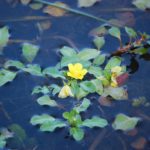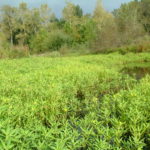Gallery:
- Water primrose
- Water primrose flower and rounded leaves
- Water primrose flower and willow-shaped leaves
- Water primrose flower
- Water primrose infestation
Common names:
Large-flower primrose willow (L. grandiflora);
primrose willow, Uruguay primrose willow (L. hexapetala);
water primrose, creeping water primrose, hairy water primrose, floating primrose, floating primrose-willow (L. peploides ssp. montevidensis)
Scientific Names:
Ludwigia grandiflora
Ludwigia hexapetala
Ludwigia peploides ssp. montevidensis,
Description:
These three species in the Onagraceae (evening primrose) family, Ludwigia grandiflora, L. hexapetala, and L. peploides ssp. montevidensis are very similar and difficult to tell apart. All three species have bright yellow flowers with 5 petals that are about an inch wide. The reddish stems root freely at the nodes. The leaves are alternate, elongated, and willow-like, although they are more oval on young plants. They were introduced through the aquatic plant trade and spread through seeds, and root and stem fragments.
Life cycle:
Height of mature plants
Large-flowered primrose willow (L. grandiflora) stems can be up to 10 feet long, while primrose willow (L. hexapetala) and water primrose (L. peploides) stems only grow up to 6 feet.
Flower color:
Yellow
Bloom time:
Late July – early September
Look-a-likes:
These plants can sometimes be confused with water purslane (Ludwigia palustris), which has small and inconspicuous green flowers and opposite leaves. They can also be confused with other yellow-flowered streamside plants such as the natives monkey flower and stream violet. However, upon closer examination, the flowers and leaves are quite different. To distinguish among these three non-native Ludwigia species a DNA test is often required.
Habitat:
Water primrose and the primrose willows are aquatic plants that grow in still or slow moving water such as wetlands, ditches, sloughs, ponds, and lake margins.
Impacts:
Ludwigia species forms dense mats that clog waterways, and this can interfere with water recreation, irrigation, fish passage, and flood control. When it clogs waterways, it also reduces the amount of oxygen in the water which can make it hard for other plants and animals to survive. As this species can out-compete other species, it can reduce the diversity of plants, and reduce the available habitat for birds and fish. It can spread and reproduce through leaf and stem fragments, as well as seeds, making control extremely difficult.
Noxious Weed Listing:
- WeedWise: maintenance
- State of Oregon: Class B, T
- State of Washington: (L. peploides), B (L. hexapetala), not listed (L. grandiflora)
- Four County CWMA: A (L. peploides), needs investigation (L. hexapetala), not listed (L. grandiflora)
- Columbia Gorge CWMA: A (L. peploides), B (L. hexapetala), (L. grandiflora)
Origin:
South and Central America, and some parts of southern North America
Links:
Oregon Noxious Weed Profile- L. hexapetala and L. peploides
Washington Noxious Weed Profile- L. hexapetala
Washington Noxious Weed Profile- L. peploides
CABI Invasive Species Compendium-L. grandiflora
CABI Invasive Species Compendium-L. peploides





